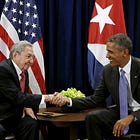Cuba Now Represents a Growing Threat
Havana is now a critical node in a hostile intelligence network: intercepting U.S. communications, expanding foreign propaganda, and offering Latin American access points to hostile regimes.
by Kevin Cohen
August 11, 2025
In May 2025, the Center for Strategic and International Studies (CSIS) released a timely report titled “Beijing’s Air, Space, and Maritime Surveillance from Cuba: A Growing Threat to the Homeland.” The report confirmed China’s construction of a new signals intelligence facility near Santiago de Cuba, just 70 miles from the U.S. naval base at Guantanamo Bay. The installation, equipped with a circularly disposed antenna array, is designed to intercept high-frequency communications and signals across vast distances, directly targeting U.S. military and diplomatic operations.
This revelation underscores the urgency of what is no longer theoretical: Cuba has become a multi-regime staging ground for surveillance, subversion, and regional disruption. China, Russia, and Iran are not simply building influence in the Caribbean — they are constructing real-time capabilities within reach of the U.S. mainland. Their combined presence suggests a new doctrine of proximity-based deterrence and hybrid warfare emerging just offshore.
Just 90 miles from Florida, Cuba is once again becoming a frontline concern for U.S. national security — not as a Cold War holdover, but as an active platform for adversaries. China, Russia, and Iran have each embedded themselves in Havana’s infrastructure, intelligence services, and foreign policy, forging a quiet but strategic alignment against the West.
Unsurprisingly, China’s presence is the most technologically advanced.




